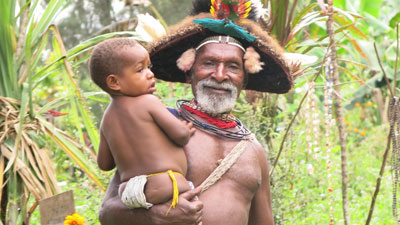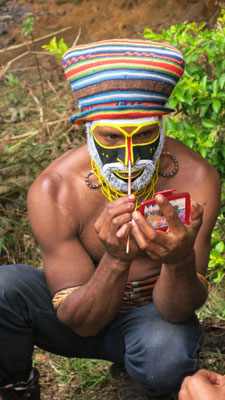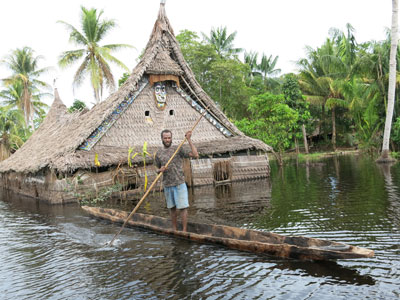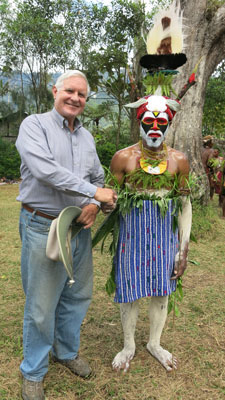Stepping into a different world on a journey to Papua New Guinea
This article appears on page 6 of the October 2013 issue.
Paddling a dugout canoe into a primeval, dimly lit old spirit house along the Blackwater Lakes of the Middle Sepik River area; watching Huli wigmen don their body adornments, and being welcomed with friendly smiles and waves from women laden with heavy bilum bags full of sweet potatoes: these were just a few of the many unique cultural experiences enjoyed by my daughter Kristin (age 43) and me (70) on a trip in May 2013 to Papua New Guinea.
The tour
We spent two weeks in PNG, along with 10 strangers (all of whom became good friends), on an adventure trip organized and escorted by Greg Stathakis of PNG Travel (Santa Barbara, CA; phone 800/676-1241).
The crowning event of this cultural journey was the Tumbuna Sing-Sing, held near Mt. Hagen. This is one of the three principal sing-sings, or Highlands shows, held in PNG each year. The other sing-sings are held in August and September and are larger, but this May sing-sing was a more intimate experience. There were only 30 of us tourists, in total, among more than 200 performers representing 10 different tribes.
Each tribe had its own distinctive costume, dance, headdress and ornamentation, including seashells, leaves, grasses, flowers, feathers and paint. Some dancers added mud, and others added oils, unusual headbands and woven bush material. Each performer was very colorful.
The performers seemed happy to have their photos taken, without asking for a fee, and were even willing to be observed and photographed as they decorated themselves and prepared for the dance performances, preparations which took a couple of hours!
Sydney to Port Moresby
Our trip started with two days in Sydney, Australia, where we enjoyed informative walks around town and had a talk each day from an expert about PNG. One lecture was given by two retired schoolteachers, a husband and wife who had taught school in PNG for 18 years and raised a daughter in the remote areas of the Sepik River. The other talk was presented by a collector who specialized in PNG artifacts.
Our tour leader, Greg Stathakis, who has traveled annually to PNG for the past 33 years, provided us with lots of information about what to expect in the land of Papua New Guinea. With such advance preparation, plus the reading and investigation I had done over the prior year, I felt in a good position to get the most out of my journey. However, the actual experience was even better than I had anticipated.
We spent two days in Port Moresby, the capital of PNG, before continuing on to the Highlands. There was plenty worthwhile to see in this big city.
We visited the exterior and interior of the Parliament House and were lucky to have a lecture and Q&A session with one of the assistants of a parliament member. We also visited with an environmental activist and heard how the growing mining industry (oil, gas, gold, minerals) is clashing with the traditional culture and the environment.
An authority on the artifacts and culture of PNG escorted us through the National Museum and the recently upgraded Nature Park.
The Highlands
To reach Mt. Hagen, the third-largest city in PNG, we took a one-hour flight from Port Moresby up into the Highlands, where we had Q&A visits with Huli wigmen and local tribesmen.
We had lots of questions about the “bride price” paid by a man to marry his wife and had discussions about how the first wife gets along with the second and third wives. While these cultural traditions seemed very different to me, I soon realized that their traditions have worked very well for them over the past two millennia and that our Western ways seemed very strange to the members of their older generations.
As an attorney, I was especially interested to learn about disputes and their resolutions in PNG. For example, if a member of tribe X were accidently injured by a member of tribe Y, the entire membership of tribe X would feel that tribe Y should pay some reasonable “compensation” to tribe X (such as, perhaps, three pigs, a feast for the tribe or $100). Such compensation would be made on a tribe-to-tribe basis rather than its just being between the individuals who were parties to the injury.
If the compensation were not paid promptly, the members of tribe X might feel entitled (or even obliged) to extract a payback injury against some member of tribe Y.
I was told that such traditional methods of dispute resolution are still practiced regularly in lieu of the new legal system that was created after PNG became an independent nation in 1975.
The Sepik River
Leaving the Highlands to explore the Sepik River area, we took a one-hour flight in a single-engine airplane that carried eight passengers, landing on a grass airstrip. Our tour included accommodation on the Sepik Spirit, a chartered, air-conditioned ship/hotel with nine guest rooms. Many side trips in a small speedboat took us into tributaries and the small, remote villages of the river basin.
During our visit, there were unusually high floodwaters. One villager said that he had been living in the second floor of his stilt home for three months without being able to set foot on the ground. He used a small dugout canoe to move about.
In one village that I visited on a Sunday, people were attending a Catholic church service on dry land. About a half mile away, I saw about 100 small canoes parked in one area, the churchgoers having rowed in from their flooded village to attend.
Many of the larger villages (500 or more people) in the Sepik River area each have their own “spirit house” or “men’s house,” with its unique A-frame construction, palm-leaf roof, a ground floor and a second floor.
Many of the tribe’s artifacts are stored on the second floor, including elaborate masks, shields, totem poles, headdresses, woodcarvings, drums and baskets. We were allowed to enter the sacred areas to view such artifacts, and many items were offered for sale.
The spirit house is also the place where young men go through a grueling 6-week “initiation” process, culminating in a ceremony involving body scarification. Numerous small razor-blade cuts are prevented from normal healing by rubbing mud into the wounds. It seems that after six months or more, the young men are very proud of their decorated bodies.
Modern life
In addition to being introduced to many unique cultural traditions on this trip, we were able to observe what is becoming a more modern, Westernized population in and around the cities. This means cell phones, T-shirts, denim, trucks, cars, radios, TVs, liquor, stores, paved roads, etc.
Many people still walk wherever they need to go, and I saw very few bicycles and no motor scooters. People will hop a ride on a local PMV (public motor vehicle), a privately owned truck or bus that travels from area to area, generally within a 10-mile range, offering low-cost rides to local people. PMVs were often heavily loaded with people and cargo.
While we were warned to be wary of pickpockets, none of us experienced any problem. In fact, we found locals to be exceedingly friendly and genuinely happy to see Western travelers enjoying their country. Smiles beamed everywhere.
Pre-trip planning
My planning for this trip involved the usual Internet searches, followed by phone calls to five tour operators. Initially, I selected Trans Niugini Tours, one of the largest operators of tours to PNG. However, after further investigation, I switched to PNG Travel (with a 14-night land tour at $9,300 per person) because I felt that Greg would provide more personal attention to details.
A trip to PNG is very expensive, regardless of which tour operator is selected. This is because in-country travel has to be done by airplane, and there are very few hotel alternatives — all of which are expensive — and there are very few travelers.
While the fully escorted tour with Greg was about 10% more expensive than the Trans Niugini tour (both of which were less expensive than most other PNG group tours), I found that the extra expense was well worth it. I received a lot of “value added” extras, such as Q&A sessions with interesting locals; daily written information about local history and culture; attention to details and matters that can go wrong, and prevention of mishaps and problems in this “land of the unexpected.”
Since visiting PNG was a once-in-a-lifetime travel experience for me, I do not have plans to return. However, I strongly recommend that well-traveled people put PNG on their own bucket lists and that the trip be made within the next few years before more changes occur, as change will certainly come soon.





